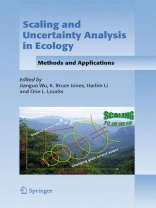Primarily, the book draws together a series of important case studies to provide a comprehensive review and synthesis of the most recent concepts, theories and methods in scaling and uncertainty analysis. It compares current definitions and ideas concerning scale within a coherent framework, and examines two key scaling approaches: similarity-based scaling, which is rooted in the idea of similitude or self-similarity; and dynamic model-based scaling, which emphasizes processes and mechanisms.
With case studies focusing on issues ranging from population to ecosystem processes; from biodiversity to landscape patterns; and from basic research to multidisciplinary management and policy-making, the book will appeal to both researchers and practitioners working on landscape issues. It will also provide a valuable resource for graduate students and professional trainees in ecology, environmental policy, resource management and global change science.
Tabla de materias
I – CONCEPTS AND METHODS.- CONCEPTS OF SCALE AND SCALING.- PERSPECTIVES AND METHODS OF SCALING.- UNCERTAINTY ANALYSIS IN ECOLOGICAL STUDIES:AN OVERVIEW.- MULTILEVEL STATISTICAL MODELS AND ECOLOGICAL SCALING.- DOWNSCALING ABUNDANCE FROM THE DISTRIBUTION OF SPECIES: OCCUPANCY THEORY AND APPLICATIONS.- SCALING TERRESTRIAL BIOGEOCHEMICAL PROCESSES CONTRASTING INTACT AND MODEL EXPERIMENTAL SYSTEMS.- A FRAMEWORK AND METHODS FOR SIMPLIFYING COMPLEX LANDSCAPES TO REDUCE UNCERTAINTY IN PREDICTIONS.- BUILDING UP WITH A TOP-DOWN APPROACH: THE ROLE OF REMOTE SENSING IN DECIPHERING FUNCTIONAL AND STRUCTURAL DIVERSITY.- II – CASE STUDIES.- CARBON FLUXES ACROSS REGIONS: OBSERVATIONAL CONSTRAINTS AT MULTIPLE SCALES.- LANDSCAPE AND REGIONAL SCALE STUDIES OF NITROGEN GAS FLUXES.- MULTISCALE RELATIONSHIPS BETWEEN LANDSCAPE CHARACTERISTICS AND NITROGEN CONCENTRATIONS IN STREAMS.- UNCERTAINTY IN SCALING NUTRIENT EXPORT COEFFICIENTS.- CAUSES AND CONSEQUENCES OF LAND USE CHANGE IN THE NORTH CAROLINA PIEDMONT: THE SCOPE OF UNCERTAINTY.- ASSESSING THE INFLUENCE OF SPATIAL SCALE ON THE RELATIONSHIP BETWEEN AVIAN NESTING SUCCESS AND FOREST FRAGMENTATION.- SCALING ISSUES IN MAPPING RIPARIAN ZONES WITH REMOTE SENSING DATA: QUANTIFYING ERRORS AND SOURCES OF UNCERTAINTY.- SCALE ISSUES IN LAKE-WATERSHED INTERACTIONS: ASSESSING SHORELINE DEVELOPMENT IMPACTS ON WATER CLARITY.- SCALING AND UNCERTAINTY IN REGION-WIDE WATER QUALITY DECISION-MAKING.- III – SYNTHESIS.- SCALING WITH KNOWN UNCERTAINTY: A SYNTHESIS.
Sobre el autor
Dr. Jianguo (Jingle) Wu is Professor of Ecology, Evolution, and Environmental Science, School of Life Sciences, Arizona State University, Tempe, Arizona. He obtained his Ph.D. in Ecology from Miami University, Oxford, OH in 1991, and was an NSF postdoctoral fellow at Cornell University and Princeton University between 1991 and1993. Dr. Wu’s research areas include landscape ecology, urban ecology, and sustainability science. His recent research has focused on urban landscape analysis and modeling, biodiversity and ecosystem functioning, and spatial scaling. He is author of over 120 journal papers and book chapters, and has been Program Chair of the US Association of Landscape Ecology (US-IALE), Councilor-at-Large of US-IALE, and Chair of Asian Ecology Section of Ecological Society of America. Dr. Wu is currently the Editor-in-Chief of the international journal, Landscape Ecology.
Bruce Jones is a Landscape Ecologist in the U.S. Environmental Protection Agency’s Laboratory in Las Vegas, Nevada. His research interests include landscape ecology, biogeography, molecular evolution, and herpetology.
Harbin Li is a Research Ecologist with USDA Forest Service. His research interests include spatial modeling and analysis of landscapes, effects of forest fragmentation on wildlife habitat, and decision support tools for ecosystem management.
Orie L. Louck has been Ohio Eminent Scholar in Applied Ecosystem Studies and Professor of Zoology at Miami University, Oxford, Ohio, and currently President of ICValue Inc. His interests concern carbon and nutrient processing of forest ecosystems and the role of biological diversity in sustaining these processes.












